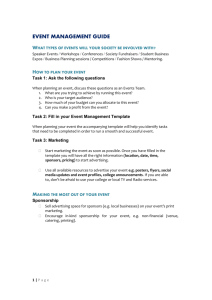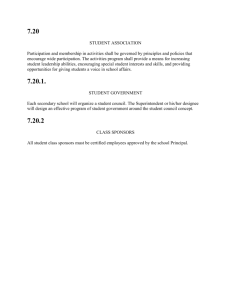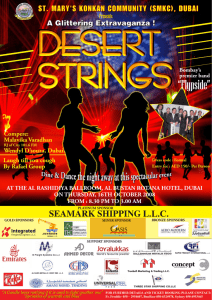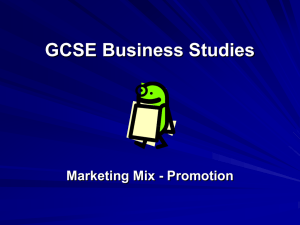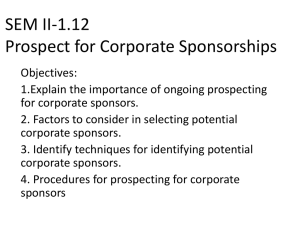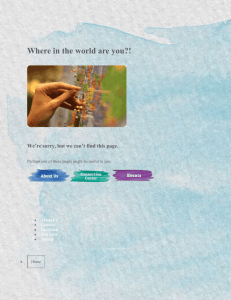powerpoint
advertisement
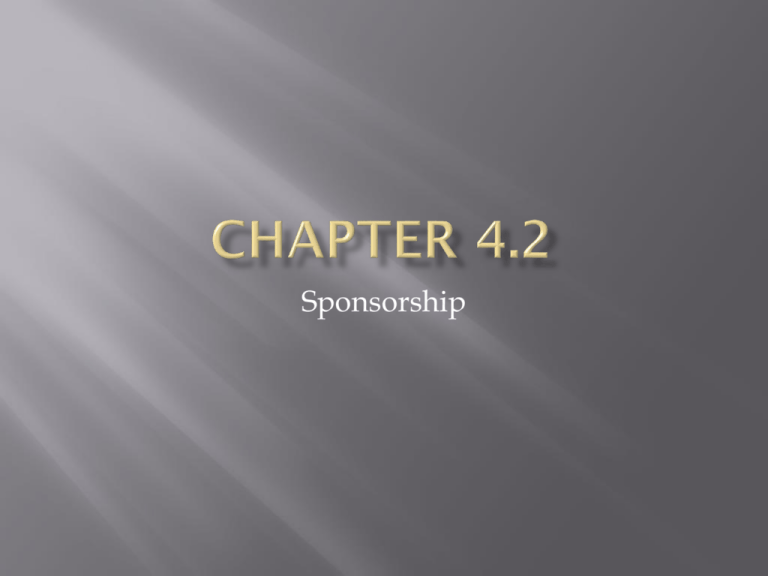
Sponsorship Sponsor-A person, organization or business that gives money or donates products and services to another person, org, or event in exchange for public recognition. Reasons for Sponsorship To increase sales To compete in a saturated area To be identified w/ an event To introduce a new product to a large audience To earn goodwill of the audience To show commitment to the community Enter new markets Enhance company’s image Sponsors monitor the value of their investments, and want a good return. Return is the profit the sponsor earns from its support of an athlete or team. Example…A vet clinic would like to see increase in patients due to sponsoring a team. Businesses watch returns since costs can be HIGH! Niche Marketing-involves researching a target market to determine the specific items a small group will buy. Businesses must understand both the large target market AND the smaller niche market for each event they sponsor. Common Niche Markets Women and men in different age groups 12-24, 25-34, 34-44 etc… Different ethnic groups Auto Racing #1 sport for fan loyalty, also most loyal fans to their sponsors Value is added to the sponsors return when they are mentioned in a race. Young men age 12-34 is one of the most sought after markets today. Sponsors are trying very hard to attract this group through extreme sports ESPN started the X Games in 1995 Very pleased with their popularity 250,000 teens attended in Who are they going after? Young market that doesn't enjoy sports like baseball and football. Soft-drink makers, tech businesses, and clothing businesses are main sponsors Sponsors come in all sizes and budgets. Few businesses can afford to sponsor major league sports, but newer sports offer attractive opportunities for small businesses Affinity Sports-Niche markets whose participants are as passionate about their sport as those of more traditional sports. Bass fishing Rope jumping 20th Century saw a backlash against sponsors by tobacco and alcohol businesses. Multistate Tobacco Settlement 1998 Tobacco sponsorship is prohibited for concerts, events which participants are under 18, or for football, baseball, soccer, and hockey. Tobacco sponsorship is limited to one event and one brand per year per business Promotion-Publicizing or advertising a product, service, or event with the goal of selling it. Purpose is to make the consumer want it People MUST know about a product in order to buy it Promotion leads to selling Promotion serves both the buyer and seller of the promo Attracting new markets and keeping old ones are equally important Goal is to find new customers or persuade regulars to buy more Promotion is a critical stage in winning new customers Maintaining customer satisfaction, loyalty, and repeat business is also a goal of promotion Before spending a cent, a company must know what it wants to accomplish. 1st…Target must be decided. Then research the five elements of market segmentation (demographics, psychographic, geographic, product usage, and benefits derived) This is to make sure the product and market suit each other. Company must decide on the message it wants to send. Does it want to persuade to try a new product? Inform customers about new features existing product? Create new attitude about existing product? Or just broaden awareness? Company must decide what it wants consumers to do. Trying a new product, coming to certain store or event, or buying more of something they already buy. Promotional Plan or Promotional Mix has 4 elements: Personal Selling Advertising Publicity Sales Promotion Personal Selling is an in-person, face-to-face communication between a seller and a customer. Example…Vendor and business buyer. A rep for a sportswear manufacturer and manager of a college bookstore. Retail store clerk and customer Telemarketers Advantages Opportunity for seller to overcome any hesitation from the buyer Seller can offer more info Can compare with similar product Or personal experiences w/ the product Often human interaction will make the sale. Even if the sale is not made, customers will return in the future if they are treated courteously. Advertising is paid communication between the product maker or seller and the audience. Effective advertising Clearly explain the benefits of a good product. Even the best advertising wont bring customers back to a bad product. Toy commercials during morning cartoons Advertising can occur almost anywhere! Publicity is any free notice about a product, service, or event. Articles in newspapers or magazines “sound bites” on television or radio Newspapers front page stories about Lance Armstrong’s victory over cancer Promoted interest in the race Free promotion not only to Armstrong but the race, other racers, and to bicycle related businesses who were quoted in the article. Publicity also means just keeping your name, event, or organization in public view. Press releases, Speeches Volunteer work Donations other than sponsorships Letters to the editor Sales promotion is any action or communication that will encourage a consumer to buy a product. Usually short term specials Limited time memberships Giveaways Coupons Items with company’s name on it Free samples

